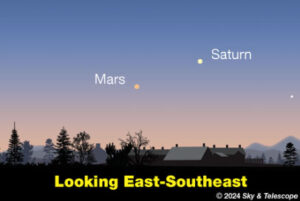Special to CosmicTribune.com, April 14, 2024
Excerpts from weekly Sky&Telescope report.
SATURDAY, APRIL 13
■ This is the time of year when, as the last of twilight fades away, the bowl of the dim Little Dipper extends straight to the right of Polaris. High above the two end-stars of the Little Dipper’s bowl, you’ll find the two end-stars of the Big Dipper’s bowl.
■ Arcturus shines brightly in the east these evenings. The Big Dipper, high in the northeast, points its curving handle to the lower-right down toward it.

SUNDAY, APRIL 14
■ Now the Moon, less than a day from first quarter, hangs under Pollux and Castor in upright-standing Gemini.
MONDAY, APRIL 15
■ First-quarter Moon (exact at 3:13 p.m. EDT). The Moon shines high at nightfall left of Pollux and Castor. Far below the Moon is Procyon. Farther below Procyon shines Sirius.
■ To the right of Procyon and Sirius is Betelgeuse, Orion’s upper shoulder. The three form the equilateral Winter Triangle.
The belt points left back toward Sirius and right toward Aldebaran and, farther on, the Pleiades.
TUESDAY, APRIL 16
■ Vega, the bright “Summer Star,” rises in the northeast these evenings. How early or late depends on your latitude and also on your longitude within your time zone.
Exactly where should you watch for Vega to come up? Spot the Big Dipper almost overhead in the northeast. Look at Mizar at the bend of its handle. If you can see Mizar’s tiny, close companion Alcor (binoculars show it easily), follow a line from Mizar through Alcor all the way down to the horizon. That’s where Vega makes its appearance.
WEDNESDAY, APRIL 17
■ Right after dark the waxing gibbous Moon shines high in the south, with the Sickle of Leo standing vertical just to its left . The top of the Sickle almost curls around the Moon.
The Sickle’s bottom star is Regulus, Leo’s the brightest. Leo himself is walking horizontally westward. The Sickle forms his front leg, chest, mane, and part of his head. Off to the left, a long right triangle forms his hind end and long tail.
THURSDAY, APRIL 18
■ The Moon is now deeper in Leo, forming an isosceles triangle (two equal sides) with Regulus to its right and Algieba (Gamma Leonis) farther above them.
FRIDAY, APRIL 19
■ Bright Arcturus climbs high in the east these evenings. Equally bright Capella descends high in the northwest. They stand at exactly the same height above your horizon at some moment between about 9 and 10 p.m. daylight-saving time, depending mostly on how far east or west you live in your time zone.
How accurately can you time this event for your location? Like everything constellation-related, it happens 4 minutes earlier each night.

Their long separation is under way: Saturn and Mars have now widened to 6½° apart. Saturn will reach opposition on September 8th, but Mars won’t get to that point in our sky until January 15, 2025. By then they will be 130° apart.
SATURDAY, APRIL 20
■ While Arcturus, pale yellow-orange, is the brightest star high in the east these evenings, lesser Spica, pale blue-white, shines lower right of it — by about three fists at arm’s length.
To the right of Spica by half that distance, look for the distinctive four-star constellation of Corvus, the springtime Crow.
SUNDAY, APRIL 21
■ As night descends, look high in the west for Pollux and Castor lined up almost horizontally (depending on your latitude).
These two stars, the heads of the Gemini twins, form the top of the enormous Arch of Spring. To their lower left is Procyon, the left end of the Arch. Farther to their lower right is the other end, formed by Menkalinan (Beta Aurigae) and then brilliant Capella. The whole thing sinks in the west through the evening.

You must be logged in to post a comment Login